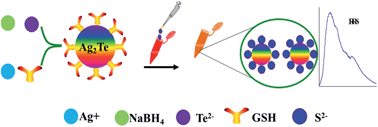A highly selective and sensitive resonance Rayleigh scattering sensor for sulfide ion detection using Ag2Te nanocrystals
Abstract
Ag2Te nanocrystals (NCs) were prepared from inexpensive and environmentally friendly raw materials by a facile route using liquid precursors at low temperatures under atmospheric pressure. The as-prepared Ag2Te NCs have been characterized by UV-vis spectroscopy, TEM and XPS. We have demonstrated that the enhancement of resonance Rayleigh scattering (RRS) was observed when sulfide ions were injected into the prepared Ag2Te NCs through the interaction between sulfide ions and Ag2Te NCs. A result which leads to a change in the conformation of the Ag2Te NCs and formed nanocomposite Ag2S/Ag2Te NCs was derived, and a novel RRS system for direct detection of sulfide was established. The possible enhancement RRS mechanism is discussed in this work. The resulting RRS sensor enables the detection of sulfide ions with a limit of detection reaching 7.8 ng mL−1 (3σ/K) in a wide linear range from 0.026 μg mL−1 (10σ/K) to 9.87 μg mL−1. The practicality of this probe for the detection of sulfide ions in urban river water samples has been validated and its advantages of simplicity, sensitivity, selectivity, and low cost have been demonstrated. The recovery of spiked sulfide ions in urban river water samples ranges from 96% to 103%. The relative standard deviation (RSD) for eleven replicate detections is 2.6%.


 Please wait while we load your content...
Please wait while we load your content...